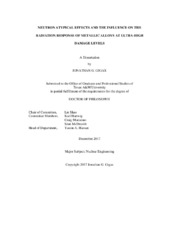| dc.description.abstract | Cladding materials in next-generation fast reactors are expected to reach damage levels of 500 displacements per atom (dpa) or greater during the lifetime of the fuel. Austenitic stainless steel cladding showed excessive void swelling that limited the lifetime of the fuel, ultimately reducing the fuel economy. Ferritic-martensitic steels have been shown to be more resistant to void swelling than their austenitic counterparts, swelling at a rate of 0.2%/dpa compared to 1%/dpa in the steady-state swelling regime. With few fast flux facilities capable of achieving 500 displacements per atom within a few decades, ion irradiation has been selected as a surrogate for neutron irradiation to quickly screen fuel cladding candidates.
Ion irradiation, however, differs intrinsically from neutron irradiation and several of these differences dramatically impact the microstructural development under irradiation. Before engaging in ultra-high damage level irradiations, an understanding of these neutron atypical phenomena is required. In this work, three of the neutron atypical effects that influence the radiation response most strongly are investigated: defect imbalance, temporal damage rate gradients, and compositional modification by Coulomb drag induced via ion bombardment. Although the defect imbalance effect is intrinsic to ion irradiation, using a static defocused beam and a specialized filtering system can reduce the effect that the latter two neutron atypical phenomena have on the microstructural development.
At low damage levels (<100 dpa), structural engineering to produce fine-grained microstructures resulted superior radiation resistance. There are no studies that have examined the response at high damage levels in order to determine the stability of the microstructure. A ferritic/martensitic alloy, T91, and its variant subject to equal channel angular extrusion are irradiated to 1000 dpa and the radiation response of microstructures compared in order to evaluate the stability of features produced by severe deformation at damage levels expected in next-generation fast reactors. | en |


